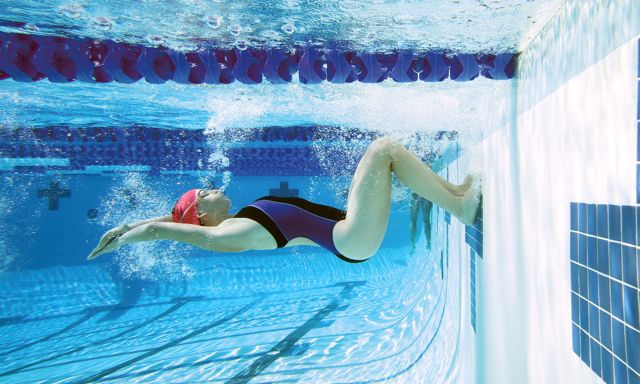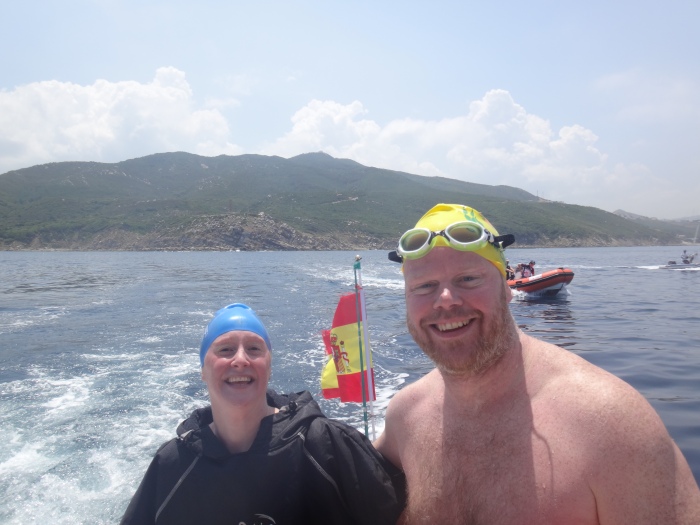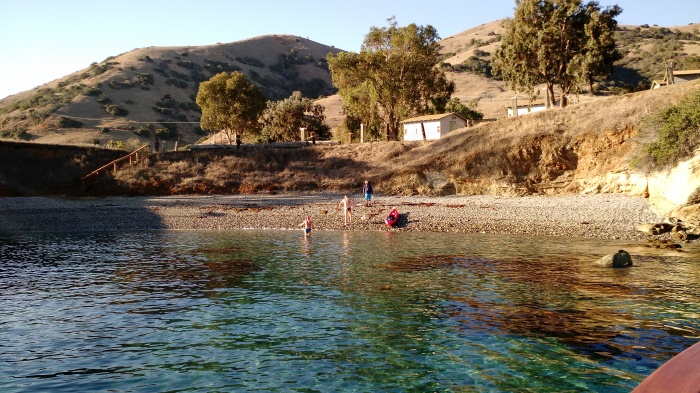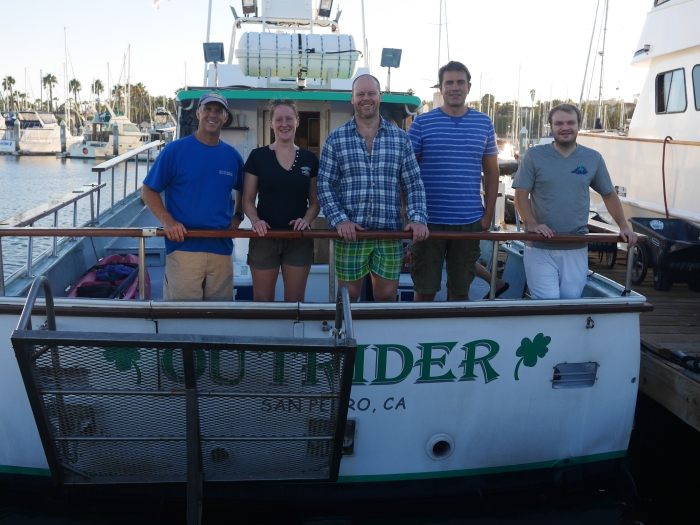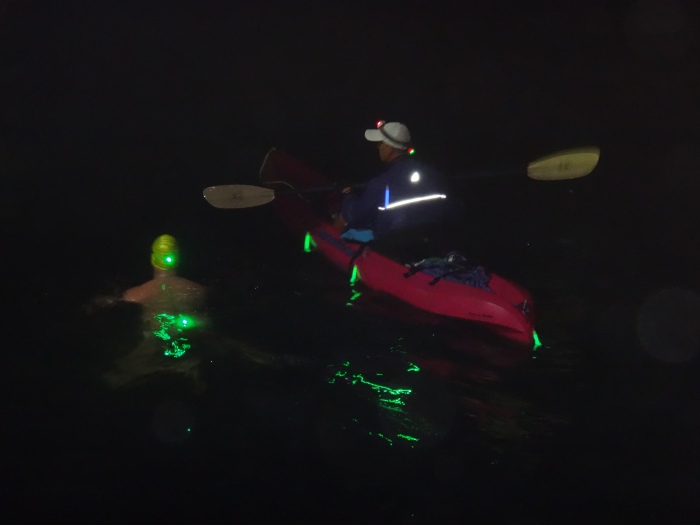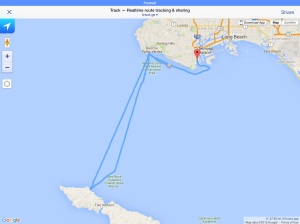The main thought going through my mind as I set off back to LA was some advice given to me by Phil Hodges. ‘Most 2-ways that fail, fail in the first couple of hours after the turn.’ This was ringing in my ears. 2 Hours after the turn would take me out of this perceived danger zone, where the finish is still a long way away, but you are already tired. 2 Hours would also take me past me longest swim to that point, the English Channel the previous year.

Starting the Return Journey
In truth though, I wasn’t feeling that great. I settled back into the same sort of rythmn as before the turn. The records show a steady 50 spm for the first 2.5 hours. At 14 hours I complained of light headedness, and was given electrolytes at the next feed. At this point we also had a near miss with a sailing boat: normally power gives way to sail, but clearly the sailing boat had not noticed me in the water, or the kayaker, so a loud hailer message from John was required to get them to move over.
Also in the first hour or so, I was accompanied by a friendly sea-lion, who swam behind me and under me for a while (see photo). That was nice, and a welcome distraction.

Playmate (may need to zoom in to see properly!)
I had been hoping that I might make better progress back towards LA, after having battled the current for a while to get in to Catalina. This wasn’t the case, though, as the current was a cross current. and was slowing me down just as much heading back as heading in. The data show about the same speed either side of the turn, at about 1 km per 30 minutes.
I also had a strange feeling that we weren’t going back the same way as we had come, which didn’t make sense. I had thought that John always went in a straight line, so why did it feel like we were crabbing across the coast?
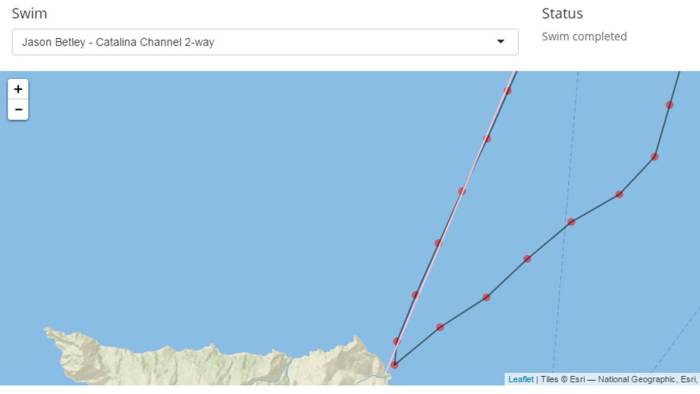
Either Side of ‘The Turn’
As it turned out, John had headed us off slightly to the east, better to set us up to take advantage of the wind behind us later on in the day. Helen informed me of this, and that John was soon going to be turning me back towards home, but it was during this 16th hour that the wheels started to fall off my wagon. I started feeling wretched. Very tired, the onset of a headache, feeling shivery and cold. And with 13.3 nm to go to the finish, and 16 hours down, moving at only 1.2 knots, the finish seemed impossibly far away.
At about 15 h 45 mins, I threw my toys out of the pram. I stopped swimming, and shouted to Helen that I was calling the swim. I told her that I wasn’t asking for permission, but just wanted to get out. I stated that I didn’t feel like I had even 5 hours left in me, let alone the 10 or more that might be required. I was pretty strong about it. I don’t know what I was expecting to hear from Helen, but what I didn’t get was any form of agreement. Instead I was told to just swim to the next feed, and that we would talk then. This is what I had written in the swim plan: ‘If Jason asks to get out, tell him to get his finger out and get on with it….’
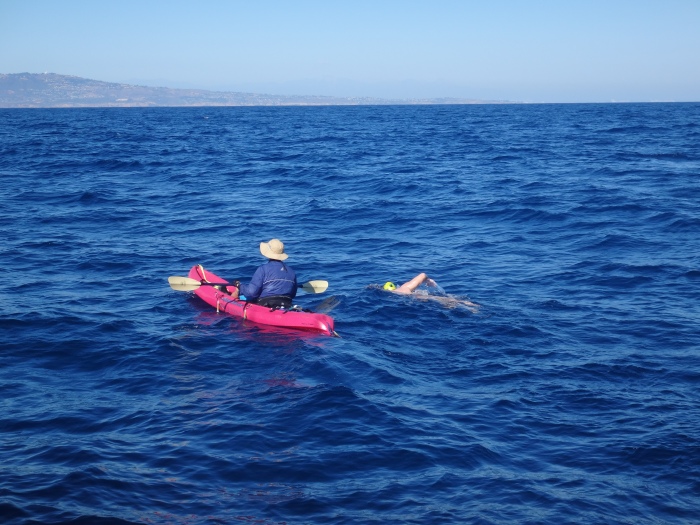
Soldiering On
I grudgingly carried on, while Helen looked busy on board. I could see her fiddling around a lot, writing stuff down on the lids of the storage boxes. And then the lids got put up for me to read. A message each from my boys Tom and Finn, wiling me on to finish. And then, for the second time in 4 hours, I cried. Different tears this time, tears of frustrated rage, as I knew Helen had me. I knew that I couldn’t throw in the towel then. I knew I had to get over this bad patch and continue.
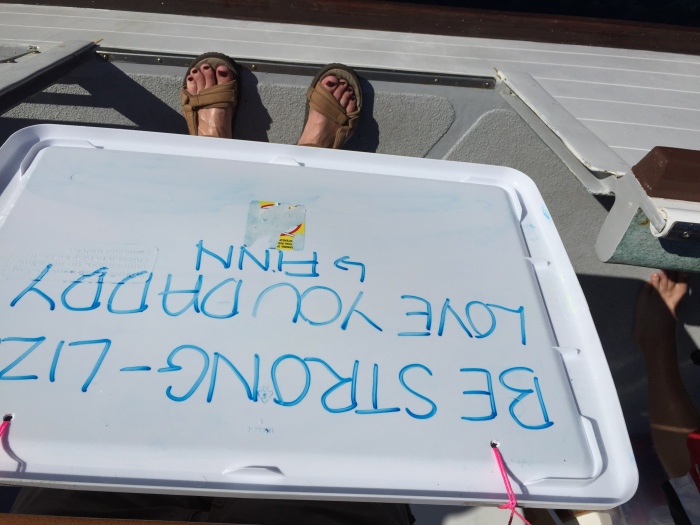
In retrospect, I think I had just ‘hit the wall’ at around 15 hours. I had previously thought that through good training I was able to go through the conversion point between burning mostly carbs to mostly fat with ease. In retrospect, I am not sure I had ever been there before. This was the first time, and I was experiencing it 16 hours in to the longest swim of my life.
Another symptom of hitting the wall is typically a loss of mental ability. This rings true with what happened. I pretty much lost the plot. Certainly asking to get out was not my plan at all. I felt like a toddler, a petulant, horrid version of me. At the 16 hour feed, Helen threw Dan in to support swim for an hour. Another master stroke from Helen. This almost immediately perked me up. My mind was taken off feeling miserable and sorry for myself, to having a swimmer with me. I didn’t want Dan to have to swim extra slow just to match my pace, so I perceptibly upped my pace again (it had been down at 47 for the previous hour), and stroked at 50 spm once more.
Having the support swimmer in with me was enough to snap me out of my low. I was still being quiet, unsmiling and uncommunicative at feeds, but much better. At this point, I also got out of the worst of the cross current, and started making better forward progress again. At 17 hours, my pace, while maintaining a constant 48-50 spm, was back up at around 2.8 kph, with a freshening wind at my feet. And that is how it stayed for the next 5 hours, throughout the afternoon.
I started to feel much better, physically and mentally, as we headed towards sunset, and my second night in the water.
20.5 Hour Feed
There were still weird things going on in the water though. It was a complicated story, and my brain was a bit bemused by it all. I knew there was a wind coming over my left shoulder, some swell going in a slightly different direction, and current in yet another. It still felt like the boat was ‘pointing in the wrong direction’ due to some crabbing across current, and against the wind.
At around 23 hours, there was another wonderful display from the sun, this time as it set into the ocean.
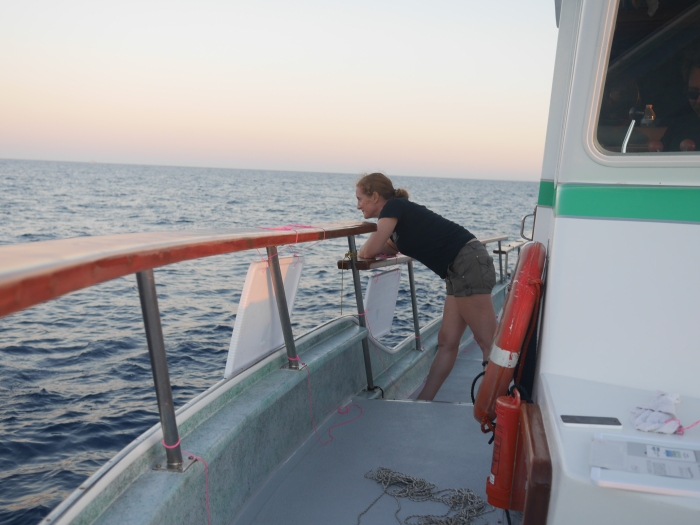
Nearly 24 Hours In – Helen Holds Vigil
Between 22 and 24 hours, I entered another phase of the swim. My stroke rate remained steady at 48-50 spm, and I was feeling fine, but my forward progress fell away markedly. The wind which had been helping me started to subside, and the current which had been in my favour during the first few hours of the swim now came back to slow me down. I was down to 2 kph once again, and because I was getting updates from the crew, I knew it. At 23.5 hours my disappointment showed, as I had only managed 0.4 of a nautical mile in the previous 30 minutes, and still had several nm to go.
I could feel my hopes of getting home around 26 hours being dashed by the adverse current, and I got angry. I thought that with only a few nm to go, this was where I was going to ‘own’ the swim. I cast my mind back to the last 90 minutes in the English Channel. After 12.5 hours I was asked to swim hard and fast to try and hit the Cap. That was what I did. I upped my stroke rate and landed it right on the nose. It had felt awesome.
But this situation was different. Instead of being swept along to the Cap on a 3 knot spring tide after only 12.5 hours, I was heading against a coastal current off Los Angeles, with 23.5 hours in the shoulders. I went for it though. Up went the stroke rate from 48 to 58. I pushed hard for 30 minutes, and really felt like I was making a difference. I was gutted then, when at the 24 hour feed, I was told I I had only covered only a further 0.4 of a nautical mile (about 750 m) in 30 minutes!
Helen was worried I was going to burn myself out, so encouraged me to ‘see if you can enjoy the rest of the swim’. ‘Easy for you to say’, I replied sardonically, and swam on, at a more sensible rate this time.
It was clear that I was battling a good current at this point though, and the effects of foolishly throwing in a ‘half hour of power’ after 23.5 hours in the water were starting to show themselves. Over the course of the next hour battling the current, I only swam 1.2 km. And my shoulders started to really hurt, especially the left one.
At 25 hours I was in so much pain with the left shoulder that I resorted to breaststroke (I have a very poor breaststroke), and one-armed front crawl. It was fully dark, and I could see the destination of Terranea Cove clearly, but I could sense how slowly we were going, and how the nose of the boat was pointing way up the coast, into the current.
Dan was in the kayak next to me, and encouraged me on. ‘You are making progress Jason. It’s not fast but if you can stay in the water long enough, you will get in’. But the guys on the boat knew just how slow it actually was, and continually encouraged me (much to my annoyance – I was doing my best!) to try front crawl again, as my breaststroke really wasn’t cutting it.
So at that point I tried to swim front crawl again, starting with 10 strokes, gritting my teeth against the horrible pain from my left shoulder. Then breaststroke. Then 15 of front crawl. Then breaststroke. And so on I laddered all the way up to 100 strokes. Every time I swam front crawl, the crew shouted encouragement. Every time I stopped, they urged me to start again. I knew why they wanted me to carry on, because it was so much faster, but just couldn’t keep going endlessly through the pain.
Bojan got in and swam with me for a while, which was both nice, and frustrating, as it was a reminder, seeing him coast alongside me, of how slowly I was moving now.
At about 26 hours, the current lessened, and I could see the nose of the boat turn in towards Terranea. But at this point I still had more than 2 km to go. It took me more than 2 further hours to get in from there. Towards the end, even the very little proper front front crawl I had been doing was finished. I made it in to the shore with a mixture of breaststroke, and one-armed Old-English backstroke.
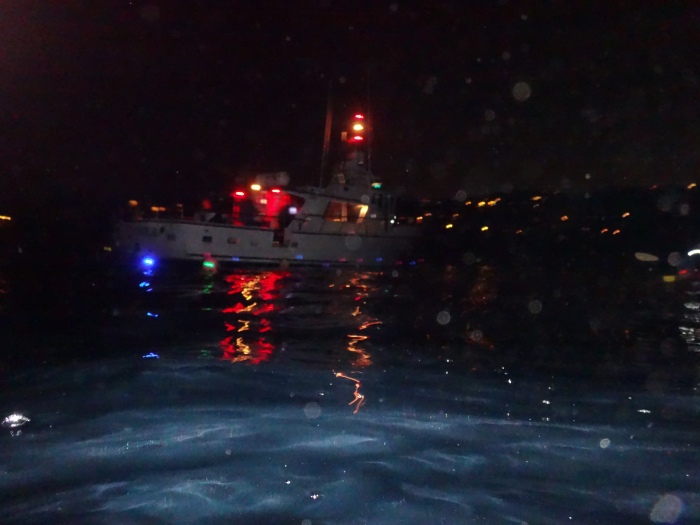
Outrider – from the Water – Taken by Bojan
In the end, after 28 hours 12 minutes 10 seconds, I crawled up the rocks where on the evening of the day before yesterday I had started the swim, and made it hesitantly to my feet. My shoulders were in agony, especially the left one. It was all I could do to try to raise the lest arm past shoulder level and salute my wonderful crew who had all come in to the beach with me. I could barely speak my mouth and tongue were so swollen.
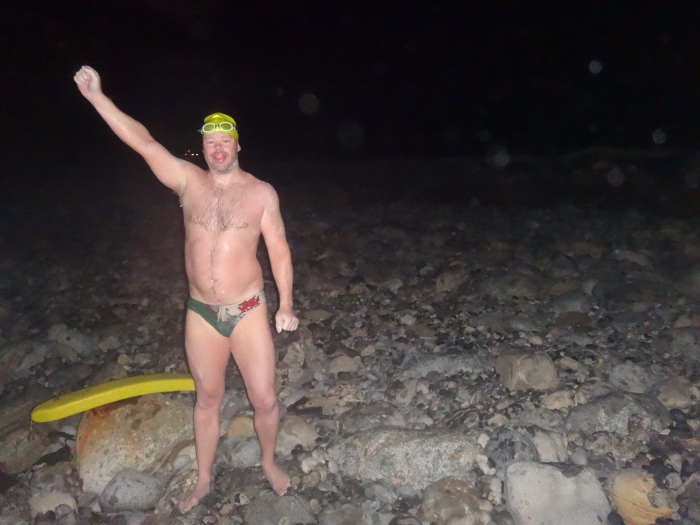
One-Armed Salute. Elation and Exhaustion.
Helen joined me briefly for a photo. Thank you Helen. I know how hard it was for you to watch me struggle for so long, and how powerless you felt to help me. But help me you did, every stroke of the way. Thank you.

Me and Helen
I collapsed back into the water at the shoreline, before Dan towed me off the back of his kayak back to Outrider. I was done. Now I could sleep. I never had to do that sort of swim again. In truth I probably never will……
There will be one more part to this blog, in which I will thank everyone on my team properly, for getting me across, and back again. I will also reflect on what we did well, and things we might do differently if we had the time again, with the benefit of retrospect. But for now I will stop, and continue to rest, and enjoy a glass of wine. Cheers!

The Full Swim. Mapping Courtesy of Evan Morrison at Marathon Swimmers’ Federation.


